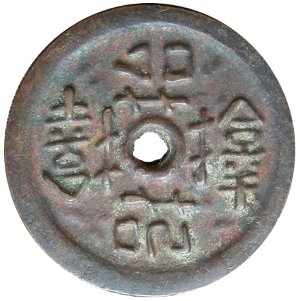
Japanese Charm with Unknown Characters
This unusual charm can be found in China but has been puzzling Chinese coin collectors for many years.
The reason is that the characters are not Chinese and are not easily recognized as Japanese, either.
However, an article in the August 1992 issue of the Japanese magazine “Collections” (收集) provides a plausible answer to the riddle.
According to the article, the charm was created in the year 1937 (Showa 12) by the director of the Japanese mint to serve as a protective amulet. It is said that the form of this charm resembles the base of the canon emplacements that were used to protect the Japanese shores from pirate ships.
The author of the article stated that when he was preparing to leave his village as a soldier in the Second Sino-Japanese War (1937-1945), a village elder gave him the coin for protection. The author wore it at his waist because the Japanese consider the lower abdomen, as opposed to the area of the heart, as the center of life. During moments of life and death, he would reach down, touch it and pray that it would help him to survive.
Also during World War II, Japanese would write these characters on a piece of paper and attach it to the roofs of their houses in the belief that the amulet would protect them from incendiary bombs dropped by American bombers.
Use of this talisman did not end with the war, however. Nowadays, Japanese can go to shops located at shrines and buy this charm to carry as a means of protection when they travel.
This amulet, which has its roots in the Second World War, now serves a role similar to the St. Christopher medal carried by travelers in the West.
Just want to thank Mr. Ashkenazy for solving another mystery. Have an example of this charm and have long been puzzled as to what it could be. Much appreciated information.
你好、
這箇文字是《国字》(kokuji).
http://f.hatena.ne.jp/nikogori12/20090509220715
讀: さ・む・は・ら (sa mu ha ra)
A Japanese blog visitor has been kind enough to provide additional information concerning the “unknown characters” used in the inscription on this charm.
The characters are written in “kokuji” script which translates as “national characters”.
Kokuji are native words used only in Japan. They are created by combining various components of Chinese characters in a way that is not used in China.
This explains why the characters are unintelligible to the Chinese.
Our Japanese friend also provided a link showing the Japanese pronunciation of the characters as “sa mu ha ra“.
This new information contributes greatly to our understanding of the charm.
Thank you very much!
新年快樂!Happy New Year!
(Sorry, my English is very poor, but I’m good at Japanese and Hungarian)
I found this “sa mu ha ra” in the 国字の字典 and 日本国語大辞典.
According to the日本国語大辞典, “sa mu ha ra” is a word of Sanskrit origin:
saṃvara > sambara (三跋羅)> sa mu ha ra.
/I wrote about this “sa mu ha ra” on my blog, too. 匈文: http://fubito.blogspot.com/2012/01/szamuhara.html /
I’m not convinced by the “sa mu ha ra” reading. I know that Japanese can have some very odd Kanji readings, but there seems to be absolutely no connection between the supposed reading and the corresponding characters. In particular why would the same character (
For some reason, only part of Mr. West’s comments were received.
I regret that this happened and hope that he will be kind enough to reply again.
Thank you for this posting.
On Zeno we have the whole series of such charms:
http://www.zeno.ru/showgallery.php?cat=10424